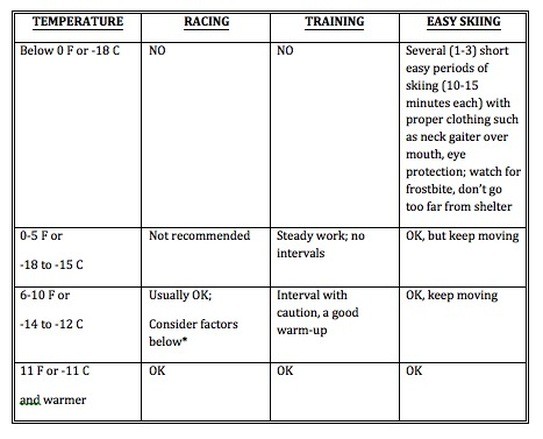Group Size
It is ideal for both safety reasons and the quality of the session to keep the group to 6-10 kids for every leader. Leaders can keep track of their kids in addition to giving them better ski instruction. It can be hard to find enough leaders with ski experience, but there are other tasks a leader without ski experience can aid with such as getting equipment on and off, taking kids to use the bathroom or to warm up, and supervising for dangers
Weather:
courtesy of NENSA
These are guidelines. In making your decision, be sure to take the following into account:
Factors that make things worse:
- wind chill factors
- long distance from heated space
- lack of shelter from wind
- poorly dressed skiers
- younger and less experienced skiers
- longer race course
- remember that skating will be very slow in extremely cold temperatures
Factors that make things better:
- plentiful sunshine
- nearby heated space
- shelter from wind
- warmly dressed skiers
- older or more experienced skiers
- shorter race course
- classic may be more satisfying for very cold conditions
Possible dangers of extreme cold:
- frostbite
- lung damage
- eye damage

Remember, skiing is supposed to be fun, not frigid!
Other Safety Considerations
Alaska is a unique place and the dangers present can be quite significant. Each village undoubtedly has it’s own dangers, most of which are probably well known amongst the locals. If you are not a local, it is a good idea to consult with someone about the specific dangers or safety issues that might be special to that area.
Some things to consider:
- Animals: things like bears, moose, rabid foxes, and rabid dogs should all be avoided
- Water/Ice: many villages are near rivers or other bodies of water. Check the ice before skiing across it
- Visibility: fog or storms can be intense in certain areas leaving low visibility
It is important to establish a safety plan before you begin. Be sure kids know what to do if they find themselves in certain situations, such as an animal encounter, getting lost, or getting injured. Be sure all adults know your plan as well. Leaders should carry extra water, food, hat and gloves with them at all times.


